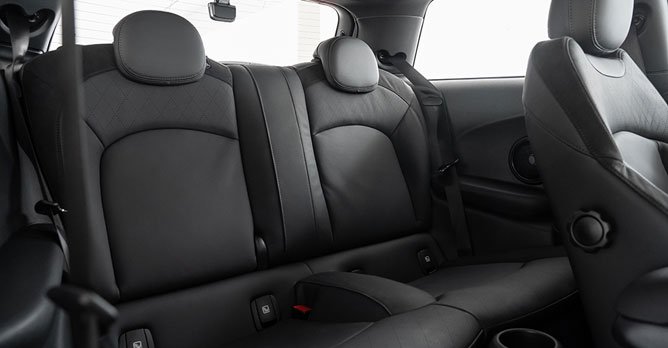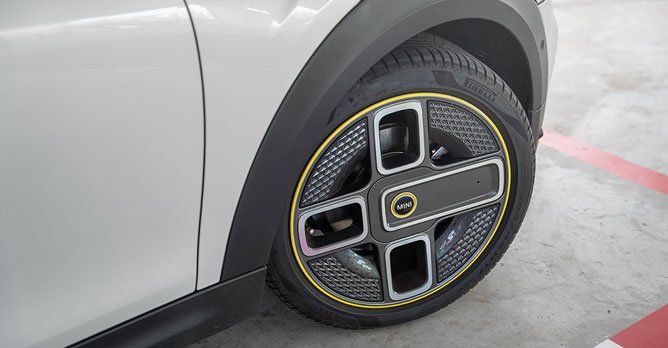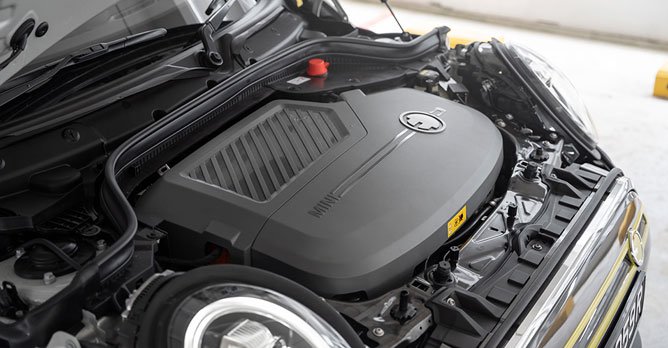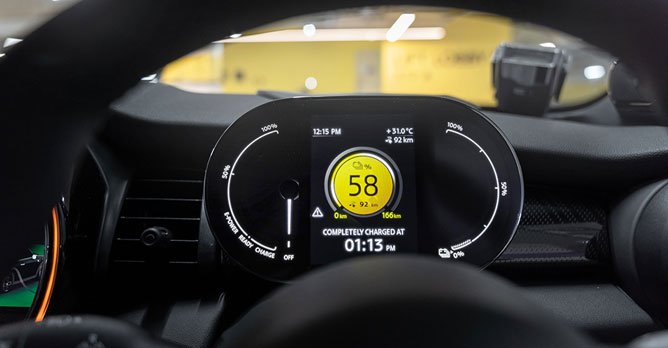MINI Electric 32.64 kWh (A) Review
22 Sep 2020|5,346 views
What We Like
Flashy yellow accents on the exterior
Urgency of electric drive
Opportunity for guilt-free motoring
What We Dislike
Best only enjoyed with one friend at a time
The car that you see above is the first fully-electric car from MINI which you can simply walk into a showroom and purchase, and it makes for an interesting proposition.
For a start, it's a retrofit of the UKL1 platform, with its lithium-ion cells squeezed into any remaining space MINI could conceivably find after the petrol drivetrain was removed.
The result is a battery capacity of 32.64kWh, which ducks under that offered by the Renault Zoe (41kWh), the Hyundai Ioniq (38.3kWh) and the Nissan Leaf (40kWh).
And if you opt for the base model of the Ioniq, the MINI is the costliest of the bunch. Add to this the fact that it is the only car amongst this group with three doors instead of five, and that its boot space - at 211 litres - is the smallest amongst them all, and it can be hard to rationally justify buying one.
Same same, but different
But if there is any brand that is well-versed at tugging at your heartstrings and making you part with your hard-earned cash for a premium compact product, it might as well be MINI.
After three days with this car I know that while I don't have any sensible reason to buy one, deep down inside, I want one.
More than I want my next breath.
Cosy cabin
Let's gets the practical issues out of the way. It's a 3-Door MINI. So as you can imagine, foot and knee room at the rear is stingy, the door pockets are narrow and the space offered in the centre console is laughable.
I did however find headroom more than sufficient at the rear, while those at the front will still find space aplenty (for a supermini that is).
But what will catch the eye in the cabin of the MINI Electric is MINI's new instrument cluster.
It adjusts together with the height of the steering wheel as per usual in other MINIs, and its matt finish does a good job of resisting glare. However, I did find that you really have to set your seat quite low to ensure that the steering wheel does not obscure your view of its top section.
Thankfully you always get the option of resorting to the head-up display to keep track of your speed, which you will be doing rather often.
GO-kart
And this is where this car excels. With 181bhp from its electric motor, the MINI Electric does have a significant standout figure with which it can compete against the rest of the electric rabble.
MINI quotes an official zero to 60km/h sprint time of just 3.9 seconds, and the car feels very much like it, despite the 70kg weight gain from the MINI Cooper S 3-Door. But you won't just be winning podiums from sprinting off at the lights.
Because having all that 270Nm of instantaneous torque paired with a short wheelbase and quick steering rack also grants you the ability to carve overtaking opportunities out of the smallest of gaps in traffic. I genuinely doubt I have yet found a better companion for my impatience during the morning commute to work.
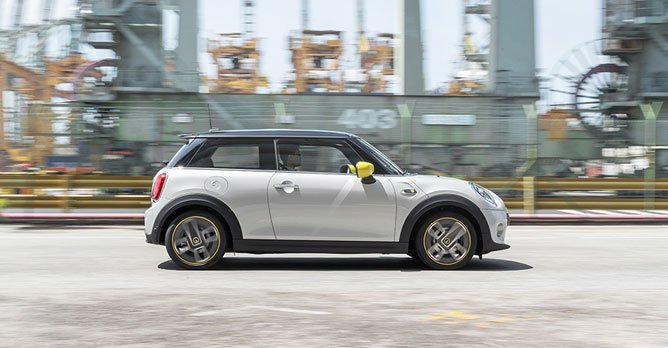
Speaking of ruts, the ride in the MINI Electric is definitely on the firmer side, but is still well within the bounds of being comfortable enough for daily driving.
And as for slowing down, the MINI Electric offers two levels of regenerative braking. The low-level option I found really easy to get used to. In light traffic you will find yourself only barely ever using the brake pedal.
At speed, the MINI Electric is surprisingly quiet in spite of the pillbox glasshouse, with only tyre noise still making its presence heard. MINI claims that improved air ducting in the undercarriage and at the rear of the car have been performed, facilitated by the removal of the exhaust system, and on the highways this improvement is noticeable.
Nickel-and-dime
My first third of the car's battery capacity was consumed after travelling 73km. Extrapolating from that gives a theoretical range of 219km, not too far from MINI's official range of 235km to 270km, and more than enough I think, to allow you to get away with charging only once every three to four days.
By my third day with the car, the stated power consumption on the 5.5-inch instrument cluster was 6.71km/kWh.
MINI states that charging from an 11kW charger will bring the battery to an 80% state-of-charge in just two and a half hours. Meanwhile, our experience with charging at a 50kW fast charger took us just 23 minutes to reach 85% state-of-charge, after starting from 35%, and it only cost me $9.40 (at a rate of $0.55 per kWh).
Is that too much to wait or pay for nearly 105km of range? Not at all I think. Aren't we expected to make a little sacrifice for the ones we love?
What We Like
Flashy yellow accents on the exterior
Urgency of electric drive
Opportunity for guilt-free motoring
What We Dislike
Best only enjoyed with one friend at a time
The car that you see above is the first fully-electric car from MINI which you can simply walk into a showroom and purchase, and it makes for an interesting proposition.
For a start, it's a retrofit of the UKL1 platform, with its lithium-ion cells squeezed into any remaining space MINI could conceivably find after the petrol drivetrain was removed.
The result is a battery capacity of 32.64kWh, which ducks under that offered by the Renault Zoe (41kWh), the Hyundai Ioniq (38.3kWh) and the Nissan Leaf (40kWh).
And if you opt for the base model of the Ioniq, the MINI is the costliest of the bunch. Add to this the fact that it is the only car amongst this group with three doors instead of five, and that its boot space - at 211 litres - is the smallest amongst them all, and it can be hard to rationally justify buying one.
Same same, but different
But if there is any brand that is well-versed at tugging at your heartstrings and making you part with your hard-earned cash for a premium compact product, it might as well be MINI.
After three days with this car I know that while I don't have any sensible reason to buy one, deep down inside, I want one.
More than I want my next breath.
Cosy cabin
Let's gets the practical issues out of the way. It's a 3-Door MINI. So as you can imagine, foot and knee room at the rear is stingy, the door pockets are narrow and the space offered in the centre console is laughable.
I did however find headroom more than sufficient at the rear, while those at the front will still find space aplenty (for a supermini that is).
But what will catch the eye in the cabin of the MINI Electric is MINI's new instrument cluster.
It adjusts together with the height of the steering wheel as per usual in other MINIs, and its matt finish does a good job of resisting glare. However, I did find that you really have to set your seat quite low to ensure that the steering wheel does not obscure your view of its top section.
Thankfully you always get the option of resorting to the head-up display to keep track of your speed, which you will be doing rather often.
GO-kart
And this is where this car excels. With 181bhp from its electric motor, the MINI Electric does have a significant standout figure with which it can compete against the rest of the electric rabble.
MINI quotes an official zero to 60km/h sprint time of just 3.9 seconds, and the car feels very much like it, despite the 70kg weight gain from the MINI Cooper S 3-Door. But you won't just be winning podiums from sprinting off at the lights.
Because having all that 270Nm of instantaneous torque paired with a short wheelbase and quick steering rack also grants you the ability to carve overtaking opportunities out of the smallest of gaps in traffic. I genuinely doubt I have yet found a better companion for my impatience during the morning commute to work.

Speaking of ruts, the ride in the MINI Electric is definitely on the firmer side, but is still well within the bounds of being comfortable enough for daily driving.
And as for slowing down, the MINI Electric offers two levels of regenerative braking. The low-level option I found really easy to get used to. In light traffic you will find yourself only barely ever using the brake pedal.
At speed, the MINI Electric is surprisingly quiet in spite of the pillbox glasshouse, with only tyre noise still making its presence heard. MINI claims that improved air ducting in the undercarriage and at the rear of the car have been performed, facilitated by the removal of the exhaust system, and on the highways this improvement is noticeable.
Nickel-and-dime
My first third of the car's battery capacity was consumed after travelling 73km. Extrapolating from that gives a theoretical range of 219km, not too far from MINI's official range of 235km to 270km, and more than enough I think, to allow you to get away with charging only once every three to four days.
By my third day with the car, the stated power consumption on the 5.5-inch instrument cluster was 6.71km/kWh.
MINI states that charging from an 11kW charger will bring the battery to an 80% state-of-charge in just two and a half hours. Meanwhile, our experience with charging at a 50kW fast charger took us just 23 minutes to reach 85% state-of-charge, after starting from 35%, and it only cost me $9.40 (at a rate of $0.55 per kWh).
Is that too much to wait or pay for nearly 105km of range? Not at all I think. Aren't we expected to make a little sacrifice for the ones we love?
Car Information
MINI Electric 32.64 kWh (A)
CAT B|Electric|14.8km/kWh
Horsepower
135kW (181 bhp)
Torque
270 Nm
Acceleration
7.3sec (0-100km /hr)
This model is no longer being sold by local distributor
All Used MINI ElectricThank You For Your Subscription.













































